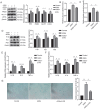Advanced glycation end products induce inflammaging in periodontal ligament fibroblasts through RAGE/AKT/mTOR/glycolysis pathway
- PMID: 40839341
- PMCID: PMC12382382
- DOI: 10.2340/aos.v84.44581
Advanced glycation end products induce inflammaging in periodontal ligament fibroblasts through RAGE/AKT/mTOR/glycolysis pathway
Abstract
Background: Inflammaging plays a pivotal role in the pathogenesis of multiple age-related diseases, including periodontitis. Advanced glycation end products (AGEs) are known to induce inflammaging and exacerbate periodontitis. However, the mechanisms by which AGEs promote inflammaging remain unclear. This study aimed to investigate the mechanisms underlying AGE-induced inflammaging.
Methods and results: Human periodontal ligament fibroblasts (hPDLFs) were extracted and stimulated with lipopolysaccharide (LPS), with prior treatment using AGEs. The expression of pro-inflammatory cytokines was measured to explore the role of AGEs in LPS-induced inflammation. Subsequently, hPDLFs were treated with AGEs and pre-incubated with 2-deoxyglucose (2-DG, a glycolysis inhibitor), Ly294002 (an AKT/mTOR pathway inhibitor), and FPS-ZM1 (a receptor for advanced glycation end product [RAGE] antagonist) to assess the levels of inflammaging markers, glycolysis, AKT/mTOR pathway activation, and RAGE expression, along with the potential relationships among these factors. Our findings demonstrated that AGEs significantly increased the expression of pro-inflammatory cytokines in response to LPS stimulation. Additionally, AGEs alone elevated the levels of inflammaging factors, including cell senescence, senescence-associated secretory phenotype factors, SA-β-Gal expression, glycolysis markers, and AKT/mTOR pathway activation. Furthermore, inhibiting glycolysis reduced AGE-induced inflammaging, while blocking the AKT/mTOR pathway, suppressed both AGE-induced inflammaging and glycolysis. Antagonizing RAGE effectively blocked AGE-induced inflammaging, glycolysis, and AKT/mTOR pathway activation.
Conclusions: Our study indicated that AGE-induced inflammaging through binding to RAGE to activate the AKT/mTOR pathway and eventually enhancing glycolysis level, which may contribute to the increased inflammatory response triggered by LPS. These findings suggest that inflammaging is a critical mechanism through which AGEs exacerbate periodontitis.
Conflict of interest statement
The authors declare that they have no known competing financial interests or personal relationships that could have appeared to influence the work reported in this paper.
Figures






References
MeSH terms
Substances
LinkOut - more resources
Full Text Sources
Miscellaneous

